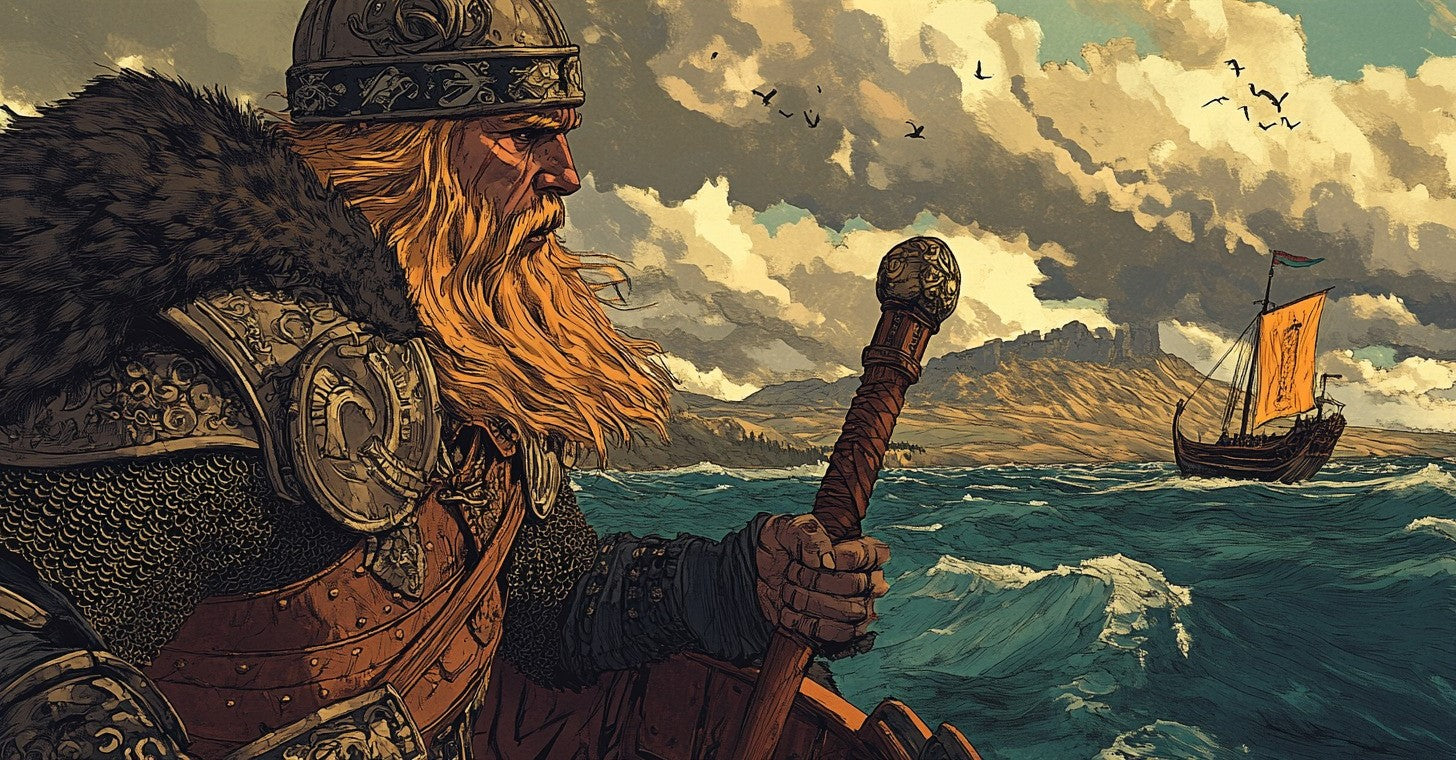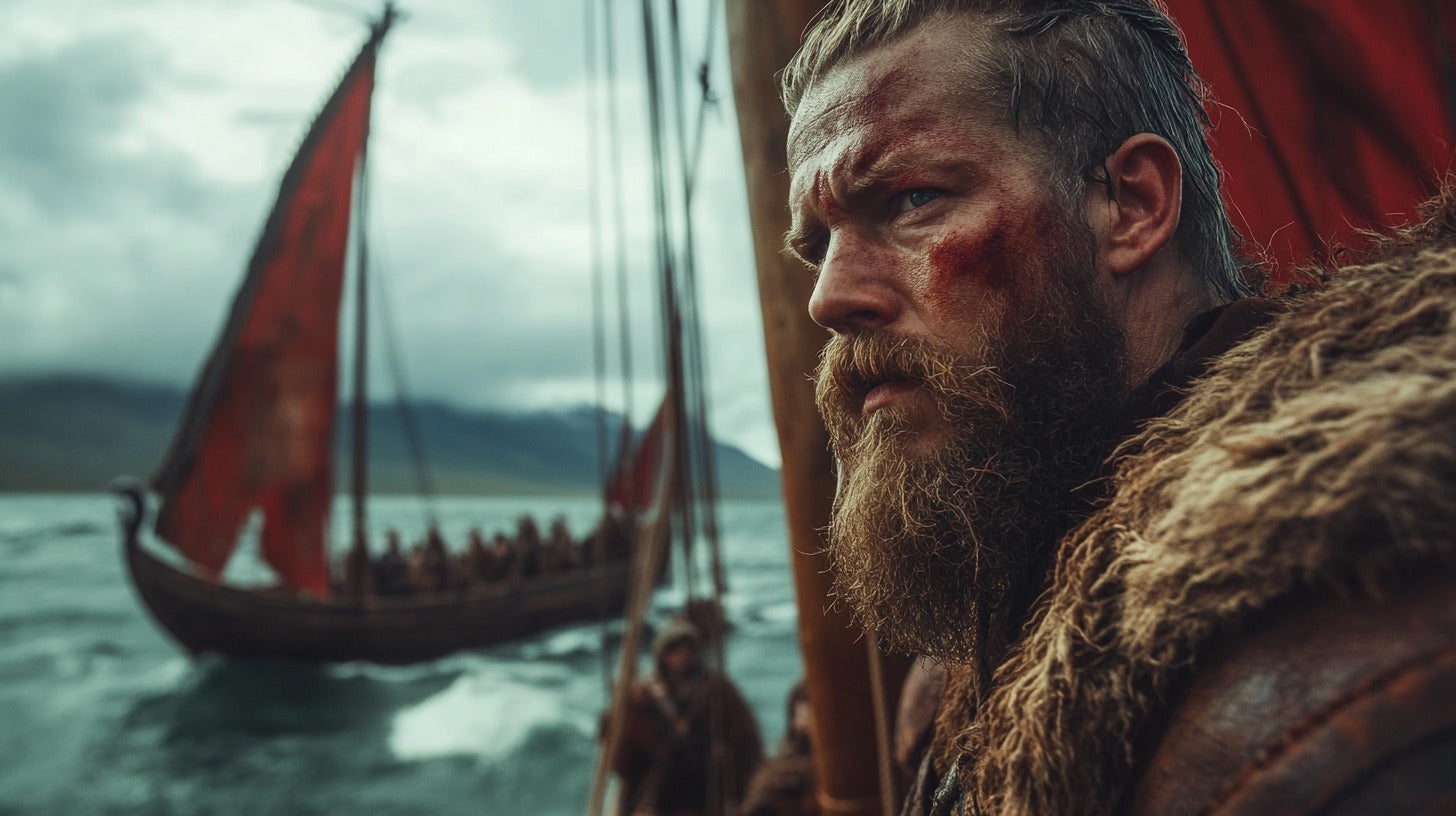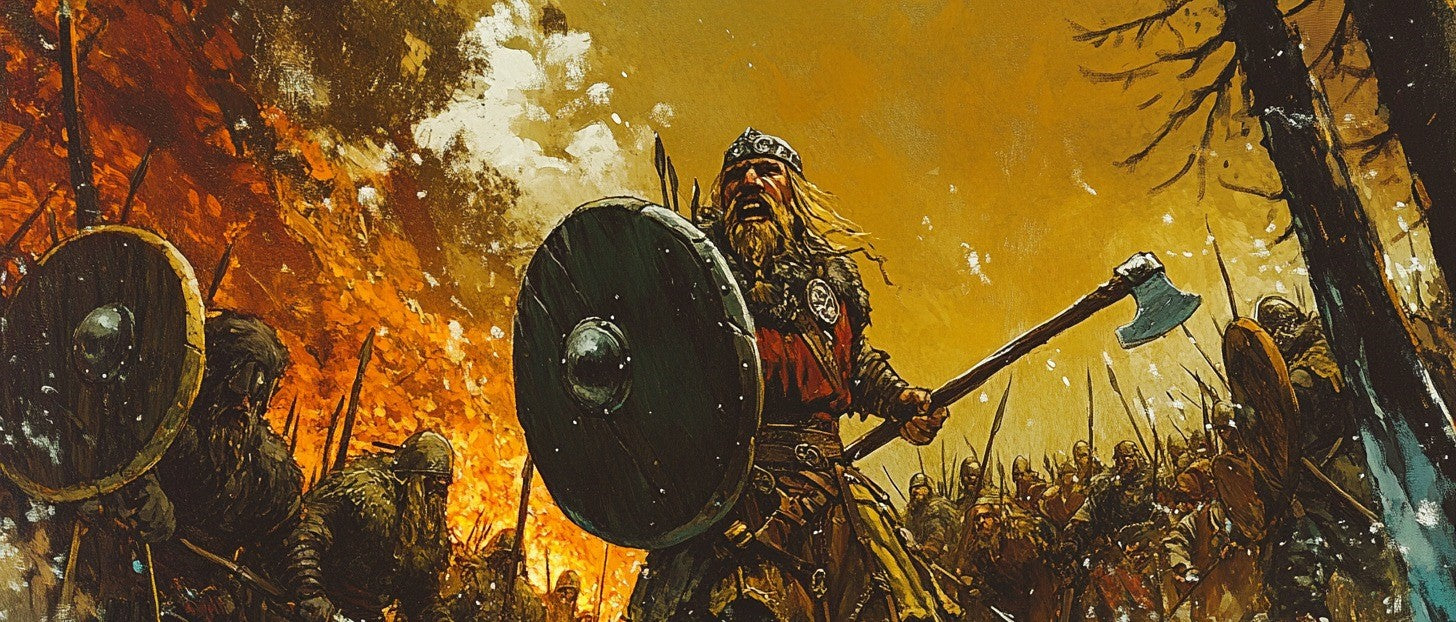
The Epic Saga of Harald Hardrada: From Exile to Legend
The saga of Harald Sigurdsson, more widely recognized as Harald Hardrada, is one of the most enthralling narratives in Viking history. His life, a fusion of adventure, ambition, and conquest, saw him traverse the harsh Norwegian fjords, the majestic city of Constantinople, and the bloody fields of England. Harald's journey is a vivid illustration of the Norse spirit, driven by an insatiable quest for power and glory.
Early Life and Exile

Harald's ancestry according the Old Norse sagas / Photo: Paganheim
Birth and Childhood in Norway
Our tale begins in the year 1015, in the rugged landscape of Norway. Harald was born into royalty, the youngest son of Sigurd Syr and Åsta Gudbrandsdatter. From his earliest days, the young prince was steeped in the lore of his ancestors, tales of great warriors and kings that would shape his destiny.
But the Norway of Harald's youth was a land divided, torn by the ambitions of rival claimants to the throne. As a child, he watched his half-brother, Olaf Haraldsson, struggle to unite the kingdom under Christian rule. Little did young Harald know that these early experiences would forge the iron will that would later earn him the moniker "Hardrada" - the hard ruler.
The Battle of Stiklestad and Escape to Kievan Rus'
The turning point in Harald's young life came in 1030, at the Battle of Stiklestad. At merely 15 years old, he stood shoulder to shoulder with his half-brother Olaf against the forces of Cnut the Great. The clash was fierce, the air thick with the song of steel on steel and the cries of fallen warriors. When the dust settled, Olaf lay dead, and Harald, wounded but alive, was forced to flee.
Like a wolf separated from its pack, the young prince had to adapt quickly to survive. He escaped east, crossing vast stretches of untamed wilderness to reach the court of Yaroslav the Wise in Kievan Rus'. It was here, in this distant land, that Harald would begin to build the legend that would follow him for the rest of his days.
Adventures in the East

Service in the Varangian Guard
Harald's exile in Kievan Rus' was but the first step in a journey that would take him to the very heart of the Byzantine Empire. In 1034, he traveled to Constantinople, that jewel of civilization that the Norse called Miklagard - the Great City. Here, Harald joined the ranks of the Varangian Guard, the elite unit of Norse warriors who served as the personal bodyguard of the eastern Roman (Byzantine) Emperor.
Battles in the Mediterranean
For the next decade, Harald's life was a whirlwind of battles and campaigns. He fought Saracen pirates in the Mediterranean, quelled rebellions in Anatolia, and even ventured as far as Jerusalem. With each victory, his reputation grew, and so did his wealth. The young exile was transforming into a seasoned warrior, his skills honed in the crucible of constant warfare.
Rise to Chief of the Varangians
Harald's prowess in battle and his natural leadership abilities did not go unnoticed. He rose through the ranks of the Varangian Guard, eventually becoming their chief. It was a position of immense prestige and power, second only to the Emperor himself in certain matters. But for Harald, it was still not enough.
Exploits in Sicily and Bulgaria
The ambitious Norwegian prince led campaigns in Sicily and Bulgaria, adding to his growing legend. Tales of his exploits spread far and wide, reaching even the distant shores of his homeland. Harald Hardrada, the exiled prince, had become a figure of awe and admiration throughout the known world.
Return to Scandinavia

Claiming the Norwegian Throne
By 1045, Harald had amassed considerable wealth and an even greater reputation. The time had come to return home and claim what he saw as his birthright - the throne of Norway. He sailed north, his ships heavy with the treasure of his campaigns, his heart filled with dreams of kingship.
Upon reaching Norway, Harald found the political landscape had shifted. Magnus the Good, his nephew, sat upon the throne. But Harald was not to be denied. Through a combination of negotiation, threat, and his formidable reputation, he managed to secure a co-rulership with Magnus. When Magnus died the following year, Harald became the sole ruler of Norway.
Conflicts with Denmark
But the crown of Norway alone could not satisfy Harald's ambitions. He set his sights on Denmark, claiming the throne through his agreement with Magnus. This led to years of conflict with the Danish king, Sweyn Estridsson. Harald's raids on Denmark were brutal and frequent, earning him fear and respect in equal measure.
The North Atlantic Expeditions

Harald's Viking spirit was not content with merely ruling Norway. He launched expeditions across the North Atlantic, raiding the coasts of England and Scotland. These campaigns served a dual purpose - to enrich his coffers and to remind the world of the might of the Norse.
In 1062, Harald made his most ambitious move yet against Denmark. He assembled a massive fleet, intent on conquering the entire kingdom. But Sweyn Estridsson proved a canny opponent, employing scorched earth tactics that frustrated Harald's efforts. After years of conflict, both kings agreed to a peace treaty, each recognizing the other's rule in their respective kingdoms.
The Final Journey: Invasion of England

Preparation and Motivations
As Harald entered his fifties, one might have expected him to settle into the role of a peacetime king. But the fire that had driven him across continents still burned bright. In 1066, he saw an opportunity he couldn't resist - the chance to claim the throne of England.
Edward the Confessor, King of England, had died without a clear heir. Harald, through a convoluted series of claims and promises, believed he had a right to the English crown. He began preparations for his greatest expedition yet.
The Battle of Fulford
In September 1066, Harald's fleet landed in northern England. At the Battle of Fulford, his forces crushed the local Northumbrian army, opening the way for a march on York. Victory seemed within grasp, and Harald could almost feel the weight of a second crown upon his brow.
Defeat at Stamford Bridge
But fate, that fickle mistress, had other plans. Just days after his triumph at Fulford, Harald's army was surprised by the forces of Harold Godwinson, the newly crowned King of England. At Stamford Bridge, on September 25, 1066, the last great Viking king met his end.
The battle was fierce, with Harald fighting in the thick of it, his legendary war-axe "Land-ravager" reaping a terrible toll. But an arrow found its mark, piercing Harald's throat. As he fell, so too did the Viking Age, its last great champion laid low on English soil.
Legacy and Impact

Coin of Harald as the sole Norwegian king
Though Harald Hardrada fell short of his final ambition, his impact on Norse and European history cannot be overstated. His life bridged the Viking Age and the Medieval period, embodying the old ways of the Norse while also bringing back influences from the Byzantine Empire.
Harald Hardrada's saga is more than just a tale of one man's ambition. It's a microcosm of the Viking Age itself - a story of exploration, conquest, and the relentless pursuit of glory. In many ways, Harald was the last true Viking king, his death marking the end of an era.
The journey of Harald Hardrada, from exiled prince to legendary warrior-king, reads like a Norse saga come to life. His travels took him from the fjords of Norway to the streets of Constantinople, from the shores of Sicily to the fateful fields of England. Along the way, he left an indelible mark on history, his name forever etched in the annals of Viking lore.
As we look back on Harald's life, we're reminded of the complex tapestry of medieval Europe, where ambition, warfare, and cultural exchange intertwined in ways that still shape our world today. Harald Hardrada may have fallen short of his ultimate goal, but in his journey, he embodied the spirit of an age - an age of adventure, conquest, and legendary deeds that continue to captivate us to this day.

The Last Viking: The True Story of King Harald Hardrada by Don Hollway
FAQs
- Why was Harald Sigurdsson called "Hardrada"?
The nickname "Hardrada" means "hard ruler" in Old Norse, likely referring to Harald's stern and uncompromising style of leadership.
- Did Harald Hardrada really serve in the Byzantine Empire?
Yes, Harald spent about a decade serving in the Varangian Guard, the elite unit of the Byzantine Emperor's personal bodyguard.
- How did Harald's invasion of England in 1066 impact history?
While Harald was defeated, his invasion weakened the English forces just before the Norman invasion led by William the Conqueror, indirectly contributing to the Norman conquest of England.
- What was Harald's connection to Yaroslav the Wise of Kievan Rus'?
Harald sought refuge in Kievan Rus' after fleeing Norway, and later married Elizabeth, daughter of Yaroslav the Wise.
- Was Harald Hardrada the last Viking king?
While not technically the last Norse ruler, Harald is often considered the last great Viking king, as his death at the Battle of Stamford Bridge in 1066 is sometimes marked as the end of the Viking Age.
References
DeVries, K. (1999). The Norwegian Invasion of England in 1066. Boydell Press.
Marsden, J. (2007). Harald Hardrada: The Warrior's Way. Sutton Publishing.
Blöndal, S., & Benedikz, B. S. (2007). The Varangians of Byzantium. Cambridge University Press.
Ferguson, R. (2009). The Hammer and the Cross: A New History of the Vikings. Allen Lane.
Davidson, H. R. E. (1976). The Viking Road to Byzantium. Allen & Unwin.








